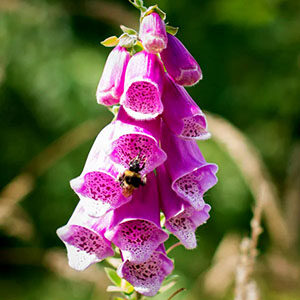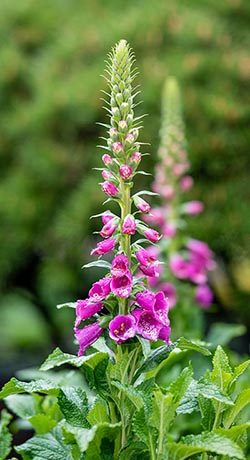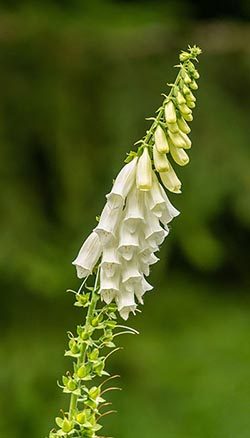
Foxglove Meaning Around the World
Foxglove meaning includes both positive and negative symbolism. Foxglove flowers are said to sometimes hurt and sometimes heal. This is because foxglove flowers can be used as medicine on the one hand and can cause illness or death on the other hand. In addition, there are many slang terms derived from foxglove meaning.
Share this page with a friend!
Foxglove Slang & Folk Names
The alphabetical list below includes foxglove name meanings throughout history from many different cultures. The list demonstrates the wide variety of slang terms and folk names given to foxglove.
Dead Man’s Bells: a reference to the poison digitalis contained in foxglove flowers
Fingerhut: German name for foxglove, reference to the single finger of a glove, also means thimble
Folk’s Gloves: term for foxglove flowers as the gloves of various types of fairies
Fox Gloves: a fox wearing these flowers to avoid being caught raiding chicken coops
Foxglove (music slang): music with an ethereal or haunting quality
Foxglove (drug slang): digitalis or digoxin that can be used as a dangerous street drug
Foxglove (sex slang): a reference to a woman’s vagina due to the shape of the flower
Golden Foxglove: a mixture of defecation and urine used to attract flies away from a camping area
Granny’s Gloves: reference to older woman who served as midwives and could gently deliver a baby
Little Glove: French name for foxglove flowers, translation of “gantelee”
Our Lady’s Gloves: foxglove flowers were dedicated to the Virgin Mary in medieval gardens
Witch’s Gloves: a reference to the poison (digitalis) contained in foxglove flowers

Foxglove Meaning and the Fairy Folk
The common name for foxglove flowers is an abbreviation of the phrase “folk’s gloves.” In this context, “folk” refers to fairy folk. Another possible origin of the name “foxglove” is due to its similarity to an ancient bell-shaped musical instrument, the fox’s glew. Yet another theory is that wild fox wear gloves from the flower so they will not be caught raiding a chicken coop.
Foxgloves and Fairies
Fairies are mythical beings who exist in a dimension slightly removed from our normal, waking reality. Though usually viewed as positive in modern times, they were once thought of as a bit more mischievous and even dangerous. Fairies can be seen by certain people or in certain circumstances.
Types of Fairies
Although fairies are usually thought of as small creatures, they actually come in many sizes and types. The small fairies associated with the meaning of foxglove flowers would be referred to as fae folk, pixies, elves or brownies. Rumor also has it that picking foxglove harms or kills the fairy folk. Most likely, this tale was told to children to keep them away from the poisonous plant.
Foxglove Spiritual Meaning
In medieval times, gardens dedicated to the Virgin Mary were called Mary Gardens. A statue of the Virgin Mary was surrounded by flowers with spiritual meanings. In these gardens, foxglove flowers are called “Our Lady’s Gloves” or “Gloves of the Virgin.”
Gardens Dedicated to the Virgin Mary
Mary Gardens were places dedicated to prayer and meditation. Formal Mary Gardens followed prescribed patterns of flower groups. Several hundred flowers have been connected to Mary, providing symbolic meaning based on the shape, color or foliage of the chosen flower.
Symbolic Flower Garlands
In the Catholic tradition, the month of May is dedicated to the Virgin Mary. A traditional ritual is the “May Crowning.” During this ceremony, a garland of flowers is placed on the head of a statue of Mother Mary. Children, often young girls, are chosen to be part of this ceremony.
Modern Foxglove Meaning
The scientific name of foxglove flowers is digitalis, a reference to the presence of powerful chemicals that can heal heart conditions if taken correctly. Thus, the foxglove flower meaning of healing. However, digitalis can also be dangerous.
Language of Flowers
In the Victorian language of flowers, foxglove flowers mean both insincerity and immortality. Again, the meaning of foxglove is both unfortunate and fortunate. The color of foxglove flowers can also affect their meaning. Foxgloves come in white, yellow, pink, red and purple.
Using Foxglove Flowers to Heal
On the positive side, the digitalis from foxglove plants is used therapeutically to increase heart contractions. Digitalis can regulate fast or irregular heartbeats. This lends credence to the foxglove flower meaning of healing.
Digitalis from Foxgloves
Digitalis is often prescribed for patients with arterial fibrillation. The active compounds are extracted from the leaves in the second year of growth. The purified chemicals are referred to as digitoxin. Too much digitoxin causes anorexia, nausea, diarrhea and blurred vision.
Foxglove Flowers as Poison
On the other hand, digitalis can kill if taken in large amounts. The danger of these compounds is reflected in other names and foxglove flower meanings including “Dead Man’s Bells” and “Witch’s Gloves.” The flower is fatal enough that children have died from drinking the water in a vase containing foxglove flowers. Thus the foxglove flower meaning of poison.
Foxglove References to Sex and Elimination
Foxglove is sometimes used as a slang term for a woman’s vagina due to the elongated bell shape. The term is also used for defecation, especially when mixed with urine. This “Golden Foxglove” is a term used by campers to attract flies away from a sleeping or camping area.
Ancient Foxglove Meaning
In addition to insincerity and danger as negative aspects of foxglove meaning, foxgloves can also mean pride. Foxglove can be associated with ambition, either for oneself or on another’s behalf. In Scandinavia, fairies are said to have taught foxes to warn other animals in the forest of the approach of hunters by ringing the foxglove bells.
Roman Mythology and Foxglove Flowers
Even further back, Roman legends link foxglove flowers to the goddess Flora. In Roman mythology, Flora touches Hera with foxglove to impregnate her with the god Mars. Foxglove are associated with midwifery and women’s magic as a result. The connection to midwifery led to even more names revealing foxglove meaning: “Granny’s Gloves” and “Granny’s Bonnets.” Elderly women and herbalists often served as midwives.
Foxglove Flowers and Immortality
Finally, foxglove flowers are also associated with immortality. They grow quickly, reseed themselves and are rarely susceptible to insects. Flowers that bloom perennially or in spite of hard circumstances are often associated with immortality. Other flowers associated with immortality include bamboo, amaranth, lilac and primrose.

Foxglove Meaning by Color
Foxgloves most commonly come in white, yellow, pink, red, lavender and purple. There are now hybrids that combine colors in a single flower. Foxglove flower meaning is influenced by the color of the blossoms. Read more about Flower Color Meaning.
White flowers symbolize purity, contemplation and innocence. Many night-flowering plants are white, symbolizing the feminine energies of the moon. Use white to give breathing space in your garden from the intensity of bright colors demanding attention.
Yellow flowers are often the heralds of spring. Sunshine yellow flowers symbolize the clearing away of the winter and stimulate clear thinking. The color meanings of yellow are enthusiasm, cheerfulness, sense of humor, fun, optimism and intellectual prowess.
Pink flowers symbolize love and healing from grief, anxiety or emotional trauma. Pink is related to warmth and love, gentleness, beauty, and an outward orientation. Pink foxglove flowers are among the more popular foxglove colors along with purple and white.
Red flowers mean pleasure, desire and vitality. In addition, red represents the will to win, love of sports and the survival instinct. Red foxglove flowers are less common than purple, white and pink. Red flowers are stimulating and eye-catching. The intensity of red flowers creates movement and drama. Accordingly, bright red flowers symbolize cheerfulness and happiness.
Lavender, purple and violet flowers carry the meanings of transformation, transmutation and a balance between power and love. Additional meanings include charisma, charm, magical abilities and tolerance. Purple and violet colors soothe the mind and nerves. Some color psychologists say purple helps to relieve tension and dissipate anger and violence.
Growing Foxgloves
Foxglove flowers thrive in soil that is rich in iron and coal. New coal fields can sometimes be located by finding masses of foxgloves growing together. Foxgloves grow well in temperate zones. They like shade, part shade and sun.
Arranging Foxglove in Your Garden
Foxglove can be grown either through seeds or divisions of plant clumps. They do not flower the first year, but flower the second and subsequent years. Their height (2-5’) makes them wonderful plants for the back row of a garden. The many colors can create a rainbow of flowers. Red foxglove flowers create a distinct marker in a garden among shorter or more delicately colored flowers.
Why Gardeners Love Foxglove
Foxglove plants often reseed themselves. This is connected to the foxglove flower meaning of immortality. They like moist soil, but also need adequate drainage. Foxgloves grow quickly and are rarely susceptible to insects. Foxglove blossoms will be bigger if they are fertilized. Foxgloves bloom in a pyramid shape with the lowest blossoms opening first and the buds remaining closed at the top.
More Flower Articles
FOXGLOVE MEANING ARTICLE SUMMARY
Foxglove meaning includes both positive and negative symbolism. Foxglove flowers are said to sometimes hurt and sometimes heal. Learn about the medicinal and more dangerous aspects of foxglove flowers in this article. Explore foxglove meaning based on colors, modern science, and historical references including numerous connections between foxglove and fairies.
Author Kathleen Karlsen
Kathleen Karlsen is a musician, artist, writer and speaker. She is the author of two books (Flower Symbols and Vocal Medicine) and over 200 articles. Kathleen, her husband Andrew, and their five children live in Bozeman, Montana. More about Kathleen Karlsen.









